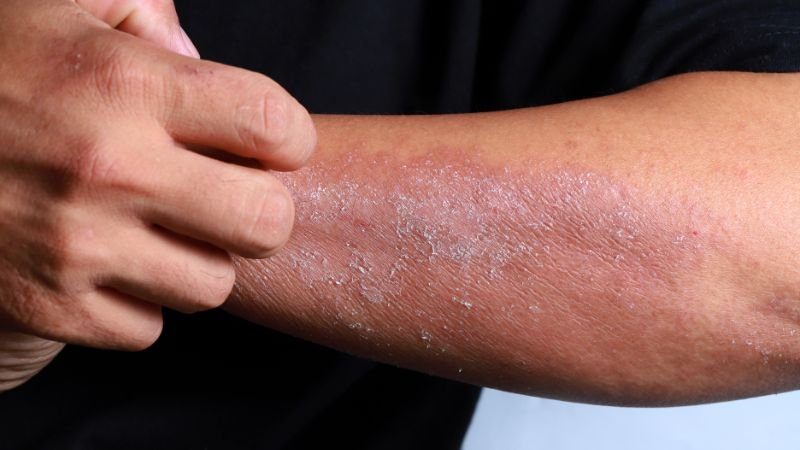What is Silicone and Its Ubiquity
Silicone, a synthetic compound composed of silicon, oxygen, carbon, and hydrogen, is notable for its heat resistance, flexibility, and durability. It’s extensively used in various products, including baby items, kitchenware, and medical devices, due to its non-toxic and hypoallergenic qualities. Despite its widespread use and general safety, silicone allergies, though rare, can occur. This article aims to shed light on silicone allergies, highlighting their symptoms, diagnosis, and management, and distinguishing them from more common material allergies.
Silicone Allergy: Uncommon but Real
Silicone allergies are extremely uncommon, contrasting sharply with more prevalent material allergies like latex or nickel. When they do occur, it’s often due to prolonged exposure to silicone-containing products. Unlike typical allergic reactions that involve immediate hypersensitivity, silicone allergies can manifest as a delayed reaction, making them harder to identify and often leading to underdiagnosis.
The mechanism behind silicone allergy is not fully understood, but it is believed to involve a delayed-type hypersensitivity reaction. This means the immune system’s response is more gradual, with symptoms appearing days or even weeks after exposure. Given its rarity, silicone allergy is often not the first consideration in cases of skin irritation or other allergy-like symptoms, leading to a need for more awareness and understanding in both medical and consumer communities.
Silicone Allergy Symptoms and Clinical Presentation
Silicone allergy primarily manifests through skin-related symptoms. These can range from mild irritations to more severe reactions, depending on the individual’s sensitivity and the duration of exposure to silicone. Common symptoms include:
- Redness and Rash: The most frequent manifestation is a skin rash at the point of contact, often accompanied by redness and itching.
- Swelling and Bumps: Some individuals may develop swelling or small bumps in the area exposed to silicone.
- Dryness and Peeling: Prolonged exposure can lead to dry, peeling skin, especially if the reaction is not promptly addressed.
- Delayed Reaction: Unlike immediate hypersensitivity reactions, symptoms of silicone allergy might not appear immediately after exposure, sometimes developing days later.

It’s important to note that these symptoms can resemble other skin conditions, such as eczema or dermatitis, complicating diagnosis. Additionally, since silicone is a common component in many products, identifying it as the cause of an allergic reaction can be challenging without careful consideration of all potential allergens involved.
Risk Factors and Populations Affected
While anyone can potentially develop a silicone allergy, certain factors and populations have a higher risk. These include:
- Frequent Exposure: Individuals who are regularly in contact with silicone-based products, especially in medical or occupational settings, are at a higher risk. This includes healthcare workers, patients with silicone medical implants, and individuals who frequently use silicone-based cosmetics or kitchenware.
- Pre-existing Allergies: Those with a history of allergies to other materials may have a heightened sensitivity, increasing their risk of developing a silicone allergy.
- Genetic Factors: There may be genetic predispositions that make certain individuals more susceptible to silicone allergies, although research in this area is still ongoing.
- Environmental Factors: Constant exposure to environments where silicone products are prevalent can increase the likelihood of developing an allergy.
It’s important to recognize that silicone allergies are still rare, even among these higher-risk groups. Awareness and proper handling of silicone products can significantly reduce the risk of developing an allergic reaction.
Silicone in Daily Life: Common Exposure Sources
The prevalence of silicone in a myriad of products underscores its importance in daily life. While safe for most, it’s crucial to be aware of its widespread use, especially in the following items:
- Baby Products: Silicone is a key material in baby pacifiers, teething rings, bottle nipples, and even some toys, chosen for its softness and safety.
- Kitchenware: Beyond spatulas and baking mats, silicone is found in pot holders, ice cube trays, and food storage containers due to its heat-resistant and non-stick qualities.
- Personal Care Items: In addition to makeup sponges, silicone appears in toiletry items like toothbrushes, bath mats, and shower squeegees for its hygienic properties.
- Medical Devices: Silicone’s use extends to tubing, catheters, and various prosthetics, highlighting its medical significance.
- Electronics: Silicone cases for smartphones and tablets, and keypads in remote controls and keyboards, utilize its durable and flexible nature.
- Automotive Parts: Gaskets, hoses, and seals in vehicles often contain silicone, chosen for its resistance to extreme temperatures and degradation.
- Apparel: Some sportswear and swimwear incorporate silicone for comfort, fit, and durability.
- Home Repair and Construction: Silicone sealants and caulks are used widely for their adhesive strength and flexibility.
This comprehensive look at silicone’s applications illustrates not only its versatility but also the importance of understanding potential exposure, particularly for those with heightened sensitivity or allergies.

Consistency of Allergy Symptoms Across Different Silicone Products
The symptoms of silicone allergy tend to be consistent in nature but can vary in severity and presentation depending on several factors:
- Amount of Exposure: Continuous or prolonged contact with silicone products may lead to more pronounced symptoms compared to occasional exposure.
- Concentration of Silicone: Products with a higher silicone concentration could potentially trigger more severe reactions in sensitive individuals.
- Type of Contact: The form of exposure, whether it’s through skin contact or internal (as with medical implants), can influence symptom manifestation.
- Individual Sensitivity: People’s responses to allergens vary greatly, with some experiencing mild symptoms, while others may have more acute reactions.
Typically, silicone allergy symptoms, such as skin rash, itching, redness, swelling, or dryness, remain the same regardless of the specific silicone product involved. However, the context, like continuous skin contact with a silicone-based wearable device versus intermittent contact with silicone kitchenware, can influence the nature and intensity of the reaction.
It’s important to recognize that similar symptoms might be caused by factors other than silicone, such as other materials in the product, environmental irritants, or different allergens. Accurate diagnosis by healthcare professionals is essential to confirm if silicone is the actual cause of the allergic reaction.
Diagnosing Silicone Allergy
Diagnosing a silicone allergy can be challenging due to its rarity and the delayed nature of the reactions. The process typically involves:
- Medical History Review: A detailed review of the patient’s medical history, focusing on any previous allergic reactions and the onset of current symptoms.
- Physical Examination: A thorough examination of the skin and other affected areas to identify characteristic signs of an allergic reaction.
- Patch Testing: The most definitive method for diagnosing silicone allergy. This involves applying a small amount of silicone to the skin under a patch, which is then monitored for several days to observe any allergic reaction.
- Elimination and Rechallenge: In some cases, doctors may recommend eliminating exposure to suspected silicone-containing products and then reintroducing them to observe if symptoms reappear.
Due to the similarity of symptoms to other skin conditions, silicone allergy is often a diagnosis of exclusion, made after ruling out other potential causes. This process requires a careful and methodical approach, often involving collaboration between dermatologists and allergists.
Management and Treatment Options
Managing a silicone allergy primarily involves avoiding exposure to silicone-containing products. Treatment and management strategies include:
- Identifying and Avoiding Silicone Products: Individuals diagnosed with a silicone allergy should be informed about the wide range of products that contain silicone, from kitchen utensils to beauty products, and seek alternatives.
- Topical Treatments: For skin reactions, dermatologists may prescribe corticosteroid creams or other topical treatments to alleviate symptoms.
- Antihistamines: In some cases, oral antihistamines can be used to manage allergic symptoms.
- Lifestyle Adjustments: Adjusting daily routines and product choices to minimize contact with silicone is crucial for those with a diagnosed allergy.
In cases where silicone is an essential material, such as in certain medical devices, consulting with medical professionals to find suitable alternatives is necessary. Continuous monitoring and adjustments based on the severity of the allergy and the level of exposure are key to effective management.
Silicone Safety and Regulatory Standards
Silicone, widely used in various products, is subject to stringent safety and regulatory standards, especially in items like baby products, kitchenware, and medical devices. These standards ensure that silicone’s use is both safe and effective:
- FDA Regulations: In the United States, the Food and Drug Administration (FDA) regulates silicone products, particularly those intended for food contact or medical applications, to ensure they meet safety requirements.
- Quality Control in Manufacturing: Manufacturers like RuiYang Silicone adhere to high-quality control standards, ensuring that their silicone products are non-toxic, hypoallergenic, and safe for consumer use.
- Continuous Research and Testing: Ongoing research and regular testing are conducted to monitor the safety of silicone products, especially in response to concerns like allergies or long-term exposure effects.
- Transparency and Consumer Education: Many companies provide detailed information about the composition and safe use of their silicone products, empowering consumers to make informed choices.
Understanding these regulations and standards can provide reassurance about the general safety of silicone products and their responsible use in various industries.
Silicone Use in an Allergic Context
The rarity of silicone allergies should not overshadow their potential impact on affected individuals. It is crucial for those at higher risk, such as people with frequent exposure to silicone products, to be vigilant about symptoms and seek medical advice if an allergy is suspected.
At the same time, the general safety and regulatory standards governing silicone use should provide reassurance. Companies like RuiYang Silicone, adhering to these standards, ensure that their products are safe for the majority of the population.